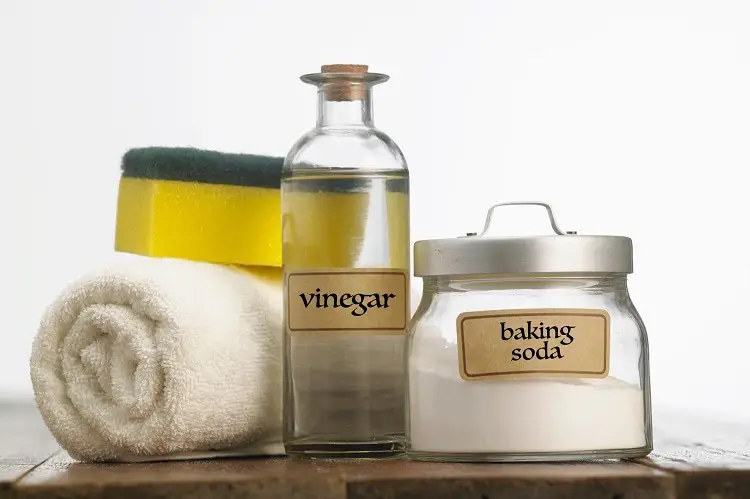Baking soda and vinegar are widely known as cleaning agents used to remove stubborn stains with strong smells.
If your kitchen or bathroom drain is clogged, your best bet is to pour these two ingredients into the drain to unclog it.
Some blockages dissolve right away when in contact with baking soda and vinegar, while others don’t. However, there’s no denying how effective the products are.
But does baking soda and vinegar dissolve hair in a drain? Yes! Baking soda and vinegar are effective in removing oily stains and strong smells and can also dissolve hair in your drainage if that’s part of the blockage.
This article will interest you if you’re having trouble clearing the hair blockage in your bathroom sink and how to prevent hair from blocking your drain.
Table of Contents
- Does Baking Soda and Vinegar Dissolve Hair?
- How to Use Baking Soda and Vinegar to Dissolve Hair
- How Long Does it Take Baking Soda and Vinegar to Dissolve Hair?
- Does Hydrogen Peroxide Dissolve Hair?
- Alternative Ways to Get Hair Out of a Drain Without Using Baking Soda and Vinegar
- How to Prevent Hair From Blocking Your Drain
- Conclusion
Does Baking Soda and Vinegar Dissolve Hair?
Combining baking soda and vinegar removes oily stains and strong smells and can dissolve hair in your drainage if that’s part of the blockage.
Frequently washing hair will leave your sink or bathtub with hair strands in the drain.
It’s easier for the hair to tangle up with other particles than to flush down completely, so after some time of washing your hair in the bathtub, the hair will form a blockage that you can’t easily take out.
There are situations where a simple hook from a wire hanger can pull out the hair, but if the hair is at a distance your hanger cannot reach, the next option is to dissolve it without tampering with the pipes.
And the only way to do it is by using baking soda and vinegar.
How to Use Baking Soda and Vinegar to Dissolve Hair

Pour ½ a cup of baking soda down the drain, followed by ½ a cup of white vinegar, and leave it for about 10 minutes.
You’d notice a reaction with bubbles coming out of the opening. This reaction is very normal and expected.
Time the reaction 10 minutes or more until the bubbles don’t come out, then pour hot water directly into the drain. Keep pouring water until the drain is clear.
Cleaning a domestic drain is easier than a heavy-duty drain.
While you can easily use baking soda and vinegar to melt the hairs and build-up in your sink at home, you can take out all the dirt from a factory-sized pipe or drain.
You’d require more than just baking soda and vinegar; in this case, you’d have to plunge or call for assistance from a drain cleaning company.
How Long Does it Take Baking Soda and Vinegar to Dissolve Hair?
This depends on the quantity of vinegar and baking soda you use regarding the drain size you want to unclog.
However, under normal conditions, the vinegar and baking soda should take about 5-10 minutes to react and dissolve the hair.
If you’re using a small quantity of vinegar and baking soda in a wide drain, you may not pour them directly on the hair.
The chemicals may spread to areas where the hair doesn’t reach or miss.
For a standard house drain, ½ cup of vinegar and baking soda is enough to melt any clog, followed by hot water.
Even after using baking soda and vinegar to melt the hairs, use a rubber plunger to pull out any leftovers in the drain.
Practically, some hair particles may hang around the drain pipes that the vinegar and baking soda can’t get to, but they don’t melt in the end. A plunger will apply pressure on these hair particles and pull them out.
Read: How to clean a sink with baking soda (7 Easy Steps)
Does Hydrogen Peroxide Dissolve Hair?
Yes. If you’re wondering about an equally effective chemical that dissolves hair in the drain, hydrogen peroxide is that chemical and works just as well as baking soda and white vinegar.
Hydrogen Peroxide abounds in almost every drugstore. You may even have it in your first aid kit and need to know that it can be a suitable cleaning agent for your clogged sinks.
It is cheap and mildly dissolves organic matter like skin, hair, and nails. If you have any hair stuck in the drain, it’ll dissolve the hair and kill any germs around the area.
Any hydrogen peroxide formula with up to 3% hydrogen peroxide will work as a suitable cleaning agent.
Use hydrogen peroxide to clean your drain in the following steps;
- Pour ½ cup of hydrogen peroxide into the drain alongside ½ cup of baking soda. Even though both can work independently, they form a stronger cleaning agent when combined.
- Avoid using the drain for some hours to prevent distorting the reaction.
- Use hot water to flush down the chemicals alongside the dirt particles.
- Pour the water repeatedly until the drain is open.
Can Bleach Dissolve Hair?
Whenever the topic of cleaning comes up, bleach automatically falls into the class of good cleaning agents.
Even though bleach is an excellent sanitizer to kill germs and deodorizer, it cannot dissolve hair in drains.
Hair and other thick blockages form a thick barricade through which only strong chemicals like baking soda, vinegar, or hydrogen peroxide can eat.
The best way to unclog drains with hair is to hire professionals or use baking soda, vinegar, hydrogen peroxide, and baking soda, as demonstrated above.
This way, you’re sure the drain is completely open and clean.
Alternative Ways to Get Hair Out of a Drain Without Using Baking Soda and Vinegar
Here are a few solutions if you have a hair clog in your bathroom sink, shower, or tub drain.
Use Needle-Nose Pliers or a Wire Hanger
You can use a wire hanger or pliers to remove hair from a drain with a removable cover, but you’ll need rubber gloves, a screwdriver, a flashlight, and needle-nose pliers.
- First, remove the drain stopper. If you’re having a hard time doing it, use the screwdriver.
- Locate the clog with a flashlight. Before you pull out the clump of hair, put on your gloves and use the needle-nose pliers.
- Straighten out a coat hanger and make a hook at the end of the pliers that cannot fit the drain or reach the clog. Please insert it into the drain, locate the hair clump, and pull it out.
- Once the drain is free of hair, flush it with one liter of hot water.
Use a Plumbing Snake
Plumbing snakes, also known as augers, are flexible and long wire or plastic tools that snake down drains to clear clogs.
If you don’t have one at home, you can buy one at your local hardware store. Augers come in several styles and sizes, depending on the purpose.
Here are a few factors to consider when choosing a plumbing snake.
- Cable thickness and length: Most augers come in a few standard thicknesses and lengths. The average homeowner or renter should be able to unblock a shower, tub, or sink using a 25-foot cable at least 14 inches thick. An auger with a 50-foot cable would be ideal for multi-story homes with bathrooms upstairs.
- Drain snakehead design: Plumbing snakes have two main types: coil heads and cutting heads. Coil or toothed heads help pull hair from drains. A cutting head has sharp blades that can cut through solid clogs.
- Manual vs. electric drain snakes: Using a manual auger, you push the snake into the drain, turn the handle to grab the clog, and pull it out. However, most major clogs can be tackled using electric snakes.
Use a Plunger
A plunger is one of the most commonly used household tools for unclogging drains. There are a variety of plungers on the market, each designed to work with a particular type of drain.
You can use a sink or standard plunger for bathroom sinks, tubs, and shower drains. These plungers have rubber cups that sit on the end of wooden or plastic handles. They are best for flat surfaces, such as sinks and tubs.
How to use:
- Place the plunger over the drain.
- Submerge the plunger in water, then pump it down and up six or seven times quickly.
- After that, remove the plunger from the drain opening and check if the water drains properly. If it does not, repeat the steps.
- Once the drain is clear, pour one liter of water to flush out debris.
Remove The Entire Drain
This is usually the last resort because it is more labor-intensive. Not so many people are willing to deal with the sight and stench of the drain. However, it’s also an alternative if you can handle it.
How to Prevent Hair From Blocking Your Drain
Hair blockage is one common blockage that almost every household deals with.
You don’t even need long hair to have hair down your drain; it just finds its way down there.
Even though this is common, there are ways you can prevent them from blocking your drain.
- Always brush your hair before getting into the shower.
- Shave or trim your hair on the bathroom floor and sweep it up. Avoid shaving in the bathtub.
- Use hair drain trappers to prevent any hairs from getting into the drain.
- Create a maintenance routine for your drain. Flush it with hot water and dish soap regularly to avoid any build-up.
- Use a fabric softener sheet. Place a used fabric softener sheet over the drain opening. The porous sheet will trap hair or debris on the surface while allowing water to flow. After your shower, ensure you throw the sheet in the trash.
Related Posts:
- Are Condoms Flushable?
- Can a Gurgling Toilet Fix Itself?
- Will Vinegar Hurt PVC Pipes? Explained
- How to remove black mold from silicone sealants in your bathroom
Conclusion
Having hair down your drain can be as annoying as it is irritating. The hair blocks the drain, traps other dirt particles, and makes the whole area look untidy.
If you’re expecting a visitor, this sight can be very discouraging. If the hair isn’t much, you can easily pull it out with needle-mouth pliers or tweezers, but if the drains are already blocked, the best thing is to safely dissolve the hair without tampering with the drainage.
If you’ve used baking soda to dissolve other tough materials, you may wonder if baking soda and vinegar dissolve hair in the drain, which this article has clarified.

